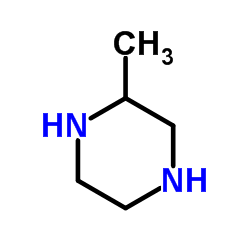119914-60-2
| Name | Grepafloxacin |
|---|---|
| Synonyms |
1-cyclopropyl-6-fluoro-1,4-dihydro-5-methyl-7-(3-methyl-1-piperazinyl)-4-oxo-3-quinolinecarboxylic acid
1-cyclopropyl-5-methyl-6-fluoro-7-(3-methylpiperazin-1-yl)-1,4-dihydro-4-oxoquinoline-3-carboxylic acid 1-Cyclopropyl-6-fluoro-7-(3-methyl-1-piperazinyl)-5-methyl-1,4-dihydro-4-oxoquinoline-3-carboxylic acid MFCD00865116 |
| Description | Grepafloxacin (OPC-17116) is an oral actively fluoroquinolone antibiotic with potent activity against community-acquired respiratory pathogens including Streptococcus pneumonia. Grepafloxacin has high tissue penetration and a promising pharmacodynamic profile[1][2][3]. |
|---|---|
| Related Catalog | |
| In Vitro | Grepafloxacin is a once-daily fluoroquinolone[2]. Grepafloxacin exhibits potent in vitro antibacterial activity against Gram-positive bacteria such as Streptococcus pneumoniae and high in vivo efficacy on the experimental systemic infections caused by the Gram-positive and -negative bacteria tested[4]. |
| In Vivo | Grepafloxacin (OPC-17116) (200 mg/kg; p.o.; Balb/c mice) displays good safety profile in terms of phototoxicity[2]. Grepafloxacin (p.o.; 25, 50, 100, and 200 mg/kg; 5 days/week for 4 weeks; Female C57BL6/J-Lyst bg-J/ mice/beige mice) has modest activities in both intranasal (IN) infection and intravenous (IV) Mycobacterium avium infection models[3]. |
| References |
[1]. Efthymiopoulos C. Pharmacokinetics of grepafloxacin. J Antimicrob Chemother. 1997;40 Suppl A:35-43. |
| Density | 1.366 |
|---|---|
| Boiling Point | 610ºC at 760mmHg |
| Melting Point | 189-192ºC |
| Molecular Formula | C19H22FN3O3 |
| Molecular Weight | 359.39500 |
| Flash Point | 322.7ºC |
| Exact Mass | 359.16500 |
| PSA | 74.57000 |
| LogP | 2.67400 |
CHEMICAL IDENTIFICATION
HEALTH HAZARD DATAACUTE TOXICITY DATA
|
| Hazard Codes | Xi |
|---|
|
~92% 
119914-60-2 |
| Literature: Journal of Medicinal Chemistry, , vol. 34, # 3 p. 1155 - 1161 |
| Precursor 2 | |
|---|---|
| DownStream 0 | |

